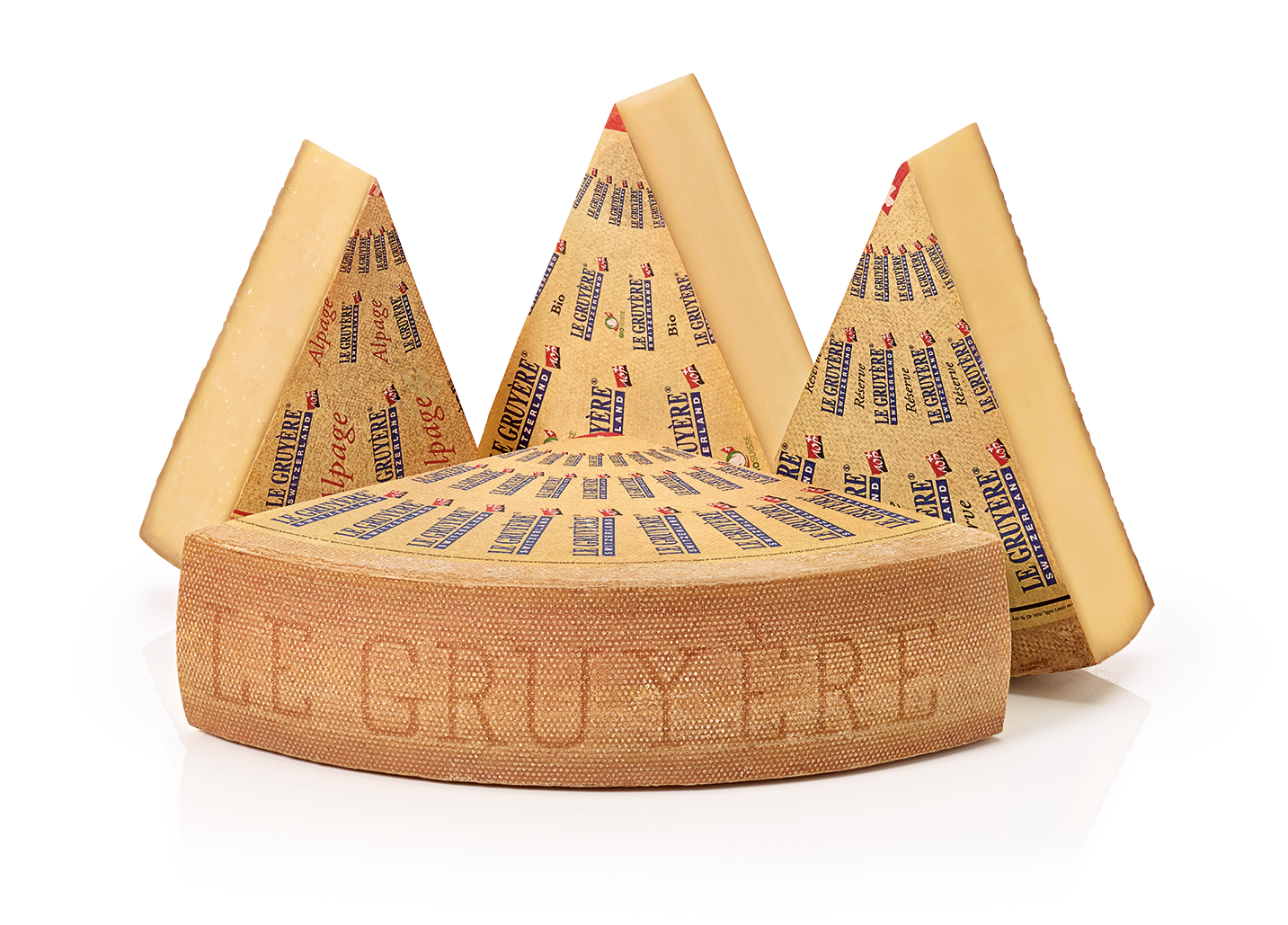Calling card

Hard cheese made from unpasteurized milk
Hard cheese made from unpasteurized milk - Federal certification
Production area: Fribourg, Vaud, Neuchâtel, Jura and some communes of the canton of Bern
Origin of the name: The region of Gruyère, in the canton of Fribourg, Switzerland
Thickness: 9,5 to 12 cm. Alpage: 9 to 11cm
Diameter: 55 to 65 cm. Alpage: 50 to 65 cm
Weight of a wheel: Between 25 et 40 kg (Ø 35 kg). Alpage: 20 to 35 kg (Ø 25 kg)
Water: 34,5 to 36,9 %
Lexicon
A
Affinage (Maturation)
The slow maturation lasts between 5 and 18 months (if not more!) depending on the taste of Gruyère AOP wished. It takes place in a cave d’affinage (maturing cellar). The wheels of cheese are regularly turned over and brushed with salt water.
Ammonia
The maturing cellar gives off a strong smell of ammonia, characteristic of the maturation of Gruyère AOP.
Average nutritional value for 100g
| Water | 36 g |
|---|---|
| Protein | 27 g |
| Fat content | 32 g |
| Minerals | 5 g |
| Calories | 1645kj/398kcal |
| Fat in dry mass | 4 to 53% |
C
Casein marking
This marking, used to identify each wheel of Gruyère AOP, is made with casein, a protein naturally found in milk. This technique gives each cheese wheel its identity and traceability.
Cheese dairy
Traditional expertise and craft are the hallmarks of all cheese-makers who produce Gruyère AOP.
Cloth
Hemp cloth used to press the cheese in the production of Gruyère d'Alpage AOP.
Cultures
Each cheese-maker elaborates his recipe for starter cultures, made from the previous day’s whey.
Curd
The cheese-maker pours the rennet into the milk. This makes the milk curdle, and this fine dense mass is called curd.
H
Heel marking
A marked steel sheet is inserted into each mold of Gruyère AOP, in order to emboss it with the denomination Le Gruyère AOP as well as with the number of the cheese dairy. This technique gives each cheese wheel its identity and traceability.
L
Land
Gruyère AOP has been recognized as AOP since 2001. This denomination is reserved for typical products, deeply rooted in a region, giving it a specific character and an inimitable flavor.
M
Maturity
According to the specifications, Gruyère AOP can be sold from 5 months.
Milk
Only raw milk from cows fed with natural forage (grass in summer and hay in winter) and without any additives or ensilage. The milk producers are all located close to the cheese dairy where they deliver milk twice a day, morning and evening. 400 liters of milk are required to make one wheel of Gruyère AOP.
Mold
A stainless steel or plastic mold is used. The curd is placed in it and pressed for 24 hours so that the cheese take a wheel form. For Gruyère d’Alpage, the curd is first put into a hemp cloth before being pressed. The denomination Le Gruyère AOP, as well as the number of the cheese dairy, is embossed in each mold of Gruyère AOP. The curd, cut into grains, is presented in this mold.
Morge (Smear)
Cette marque servant à identifier chaque meule de Gruyère AOP est composée de caséine, une protéine naturellement présente dans le lait. C’est une technique donnant identité et traçabilité à chaque meule.
Morge
Dampness helps this protective rind to form, during the maturation process, from the outside to the inside.
O
Opening
The presence of openings is possible but not essential. The diameters of the holes can range from 4 to 6 mm. Small cracks are allowed if they are closed and isolated.
P
Pressed
Gruyère AOP is a pressed cheese, which means that the curd presented in the mold is pressed for almost 24 hours, with an applied force of up to 900 kilos.
R
Raw material and composition
Only raw milk from cows fed with natural forage (grass in summer and hay in winter), no additives, free from lactose. Federal certification
Rennet
It is used to curdle milk, and contains an enzyme called chymozin, which is found in the stomach of young calves (rennet stomach).
S
Salt Bath
As soon as they are out of the molds, the wheels of Gruyère AOP are immersed in a salt bath (called brine) at 22% concentrate, for 24 hours.
Shapes and appearances
A wheel of Gruyère AOP is round with a smeared, grainy, uniformly brownish and healthy rind. The outer edge, which is called the “heel”, is slightly convex.
T
Taxation
At four months, the wheels of Gruyère AOP are checked and taxed by a neutral commission, made up of experts of the cheese industry. They can display the name Le Gruyère AOP only after this taxation, if they meet certain specific criteria (opening–texture–outer appearance–taste).
Texture
The cheese is smooth to the touch with a slightly damp feel. It is soft, moderately firm and not very crumbly. Its solid ivory color varies according to the season.
Traceability
Each wheel of Gruyère AOP bears a casein marking with the number of the wheel and of the cheese dairy, as well as the manufacturing date. The marking Le Gruyère AOP, along with number of the cheese dairy, stand out on the outer edge of the wheel, called the “heel”.
Tranche-caillé (Cheese harp)
Once the milk has curdled, the cheese-maker cuts it with a cheese harp, until the granules are the size of wheat grains.
Tranche-caillé
Une fois le lait caillé, le fromager le découpe à l’aide de tranche-caillé, jusqu’à l’obtention de grains de la taille d’un grain de blé.
V
Vat
Le Gruyère AOP can only be produced in a copper vat.
